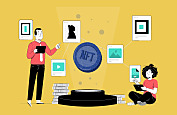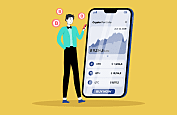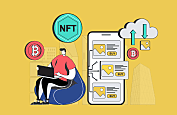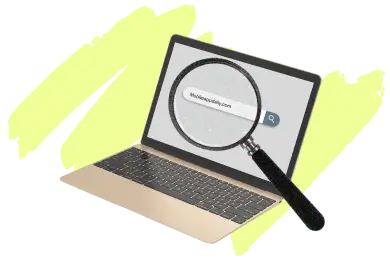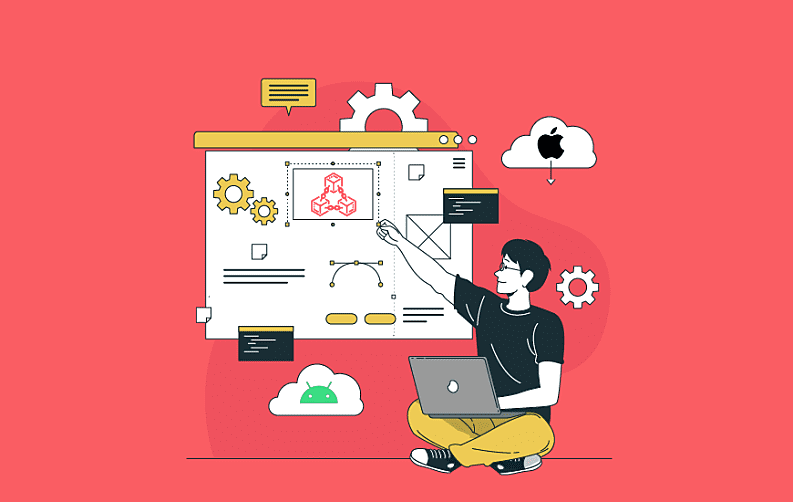
Blockchain trends are taking over multiple industries due to their security and transparency features. From securing healthcare data with blockchain to making the financial processes safer and more efficient, the technology is contributing enormously across the globe. Now, some common examples of blockchain are smart contracts, decentralized applications, decentralized servers, cryptocurrencies, Non-fungible Tokens (NFTs), etc. But in this blog, we are mainly focusing on the creation of decentralized apps built using blockchain technology for Android and iOS platforms.
A properly built blockchain mobile app can provide a decentralized solution that minimizes the number of middlemen, promotes transparency, and assures data security while also preventing illegal access. As a result, while designing a blockchain mobile app architecture for Android and iOS, this technology can be used in place of the traditional base. In this blog, we are focusing on a few steps that can answer the question “how to build a blockchain application?”.
Step 1- Creating an Idea
Before you begin designing your application, you must first consider an idea, just like you would with any other product. At the same time, you must be certain that a blockchain is truly required before implementing it. So, if you want to make a mobile video game, a torrent client, an online magazine, an aggregator, or whatever, you won't need the blockchain because it offers no advantages over the traditional approach. The following scenarios will benefit from blockchain technology:
- Payment gateway, insurance service, online store, charity: If the mobile application will function with users' money, smart contracts and blockchain will be able to ensure transaction honesty and reliability while also reducing transaction fees and the number of intermediaries.
- If you wish users to trust you, you must first earn their trust. This is critical if you're developing blockchain applications for Android or iOS that includes a voting feature, such as for primary elections, leadership elections, or deciding where and how to spend charitable contributions. Without divulging the secret of the vote, blockchain can bring transparency and verifiability to such plebiscites and thus blockchain application development might be the best pick here.
- If you need to automate business procedures, you've come to the right place. Smart contracts, when properly implemented, can automate more routine document flow and payment operations. Smart contracts are already in use to automate customs clearance, real estate deals, and trace the origin of commodities, to name a few examples. Modern blockchain applications are able to support and sync with Smart contracts to provide better efficiency.
- If you require the most dependable identity and/or verification method. Blockchain has demonstrated its utility in areas such as personal identification, real estate registration, and copyright.
- When you require a higher level of data security, one of the best existing solutions is to develop blockchain applications. The most basic example is safeguarding a patient's personal information when talking with a doctor.
Step 2- Contacting a Technical Partner
After you've decided if you want to develop blockchain applications, the following step is to find a developer. You'll need a technical partner because, unlike WordPress sites, building a mobile app on the blockchain using templates will not work. Blockchain necessitates specific expertise and skills, as well as a 15-30% general price increase.
Step 3- Choosing a Platform
The next step in blockchain app development for iOS and Android is to choose which blockchain network to build your product on. The decision must be based on the properties you require.
The following are a few of the most common choices among developers:
- The most popular alternative for blockchain mobile app development is Ethereum, which uses the Solidity programming language to allow you to design a blockchain application and create your own ecosystem. Most projects that rely on decentralization, transparency, and security will benefit from it.
- TRON is a free worldwide financial system that makes it simple and inexpensive to exchange tokens or digital content. For instance, game items in online games or Netflix movies and TV episodes. The unique feature of TRON is that its blockchain enables you to perform such swaps immediately and with a very cheap commission, making even one-dollar trades profitable. You can leverage TRON for your blockchain mobile app development projects.
- Hyperledger is a corporate-focused platform from the Linux Foundation. It enables you to create your own centralized or hybrid blockchains with unique access controls. You'll need a development team that knows Go, Java, and JavaScript to build an Android and iOS app on this platform. Hyperledger is the best technology you can use at the moment for Android and iOS blockchain development.
- IOTA is an open-source Internet of Things distribution ledger that employs a directed acyclic graph (DAG) rather than the traditional blockchain. Features include commission-free transactions, the ability to perform an unlimited number of transactions at once, and a speedier confirmation time. This allows for more efficient and secure interactions between IoT devices.
- For the banking sector, R3 Corda is a good option. Its key characteristic is that it integrates with legacy systems quickly and easily.
- EOS is a platform that focuses on enterprise solutions that leverage smart contract capabilities, decentralized application hosting, and decentralized storage to totally address scaling difficulties.
Step 4- Application Framework
The process of blockchain Android app development or iOS blockchain development is comparable to that of constructing a house. Before you begin laying the foundation, you must first create an architectural plan that will show you what type of house you will be building and what materials you will use. Your application's framework is the same architectural blueprint that you'll utilize to create your software product.
Frameworks reflect a program's core structure, appearance, user route, and approximate appearance of application screens, among other things. Developers can use such a scheme to figure out what features they need to add and how long it will take them to do so, which helps them budget for the project. To understand “how to create a blockchain app?” properly, here are two crucial steps you need to understand -
Frameworks development usually requires two steps:
- Creating a framework with a low degree of precision. A preliminary schematic illustration to help you rapidly gain a sense of your application's core structure. Most people find that visualizing a project is easier than presenting it in the form of text, tables, and diagrams.
- A high-precision framework is being built. Annotated blocks are replaced with images, ready-made articles (texts), and links under this approach.
Step 5- Creating an Interface
After you've built the framework, you can start designing an appealing user experience for your blockchain application. This is a crucial stage because it determines how the user perceives the interface: nice colors, easy-to-use icons, and seamless transitions between displays.
Or vice versa: it's unclear what to do and how to do it, there are small icons that can't be clicked, and a toxic color scheme.
At this point, designers should perform the following:
- Define the style. Several image sets (mood boards) are being created to depict application screens with various color schemes, font compositions, buttons, and illustrations. These images are delivered to the customer and/or focus group, who select the best and most appropriate for the niche.
- Develop a design concept. Its purpose is to show you how the finished application will look. If the previous stage only provided a general direction, the concept is intended to cross this direction by filling the interface (high-precision framework). Typically, for this, they create a complete design of 1-3 application screens, which are then sent for approval. Designing a prototype look is always a good idea to avoid any possible modifications in the later stages of development.
- Create all of the screens. If the concept is sound, designers move on to finalizing the interface's appearance, resulting in a complete schematic structure of all interface screens. The screens are then assembled into an interactive prototype, which provides the most accurate experience of using the application without coding it.
- Make an interface animation. Designers define how icon clicks, screen transitions, video/image opening, and so on will look during this stage. Typically, the animation is created with Adobe Photoshop or another tool, and then videos are created from it. The customer requires videos to understand how the animation will appear in the final version, as do developers who will be guided by these videos when implementing the application's design and functionality in code.
- Make materials for the developers. After the interface has been completed, the designers send the developers sprites, fonts with all icons, a UI Kit with repeating interface elements and their states, and all other materials with documentation.
Conclusion
With the surge in interest in blockchain over the last year, many businesses have begun to invest in these digital solutions. However, the industry is difficult and complex; not everyone is capable of developing a well-thought-out app that will help improve the world with cutting-edge technology. If blockchain sounds interesting to you, maybe investing in crypto will also prove compelling. If so, head over to CEX.IO and get yourself some cryptocurrency.
In the end, hopefully, this guide on creating blockchain apps for Android and iOS users was helpful and answered questions such as “how to build a blockchain app?”. We created this guide for businesses and blockchain app development companies that want to develop dApps but don't know where to begin. You can also visit MobileAppDaily to stay updated with the latest trends from the app development industry across the world.









